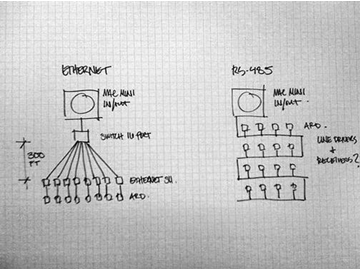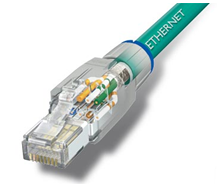|
August 2011
Article
AutomatedBuildings.com
|
[an error occurred while processing this directive]
(Click
Message to Learn More)
|
The Unheralded
Network Topology
RS-485 may be the “forgotten” or “taken for
granted”
“boring” network, but it is the mainstay of many building and
industrial automation systems.
“This simple process of
focusing on
things that are normally taken for granted is a powerful source of
creativity...”
Edward de Bono, Writer, leading authority in field of creative
thinking. (b.1933)
|

Jim
Sinopoli PE, RCDD, LEED AP
|
Ethernet
networks and information technology infrastructure have
steadily penetrated nearly all building systems and networks. Decades
ago Ethernet was primarily used to connect desktop PCs to application
servers for databases, printers and the Internet. Over time
traditional telephones went the way of Ethernet via
Voice-Over-Internet-Protocol (VoIP). Next there were a series of analog
building devices and systems taking on some Ethernet and IT
technologies: video surveillance cameras, access control card readers,
IPTV, Wi-Fi controllers, BAS network controllers and a slew of other
specialized devices. All of the databases, workstations and
servers of today’s modern building systems, such as lighting or BMS,
are all evolved from IT infrastructure. Despite its dominance,
Ethernet networks are not the sole network topology in building
systems, they are probably not the dominant network topology and in
some cases not even the right or appropriate network topology for
particular building applications. Unquestionably Ethernet is
ubiquitous, popular and visible - but in the guts of most buildings are
RS-485 networks. RS-485 may be the “forgotten” or “taken for granted”
“boring” network, but it is the mainstay of many building and
industrial automation systems.
Applications
When you take a look RS-485 applications it’s not so much where do we
use RS-485, but rather, where don’t we use RS-485. Much of the
building’s electrical equipment will typically be managed and monitored
via a RS-485 network, including electrical distribution, switchgear,
back-up generators, UPSs, ATSs, vehicle charging stations, etc. It’s
probably an RS-485 network that’s connecting and monitoring power or
flow meters and providing data on electrical, water and
natural gas consumption, and onsite power generation from wind or solar
sources. So if you have an energy management application, the energy
data is probably being gathered by an RS 485 network. You’ll also see
RS-485 used for BAS field devices and sensors, for monitoring and/or
managing boilers, CRAC units, elevators, video surveillance cameras,
specialized systems using PLCs, lighting control, shading systems,
audio systems, and home automation systems. RS-485 is used on factory
floors and even for “vehicle buses”, which are essentially networks to
monitor and manage such vehicles as aircraft. Many of us simply don’t
realize or appreciate the extensive utilization of RS-485.
Ethernet vs. RS-485
 Ethernet
and RS-485 are quite different. Ethernet topology as we know
it today is a star or “hub and spoke” configuration; interestingly,
early Ethernet used transceivers on a coaxial bus, somewhat like the
RS-485 topology. Each Ethernet outlet is typically “home run” back to
the IT network switch in the nearest telecom equipment room. RS-485
topology is different; it can be point-to-point or multi-drop with
multiple nodes, or a bus topology which is communicating
bi-directionally over a single twisted pair. It has a resistor at each
end of the bus to reduce electrical noise interference. It also
typically operates in a master-slave configuration, where the master
initiates all communication to the nodes.
Ethernet
and RS-485 are quite different. Ethernet topology as we know
it today is a star or “hub and spoke” configuration; interestingly,
early Ethernet used transceivers on a coaxial bus, somewhat like the
RS-485 topology. Each Ethernet outlet is typically “home run” back to
the IT network switch in the nearest telecom equipment room. RS-485
topology is different; it can be point-to-point or multi-drop with
multiple nodes, or a bus topology which is communicating
bi-directionally over a single twisted pair. It has a resistor at each
end of the bus to reduce electrical noise interference. It also
typically operates in a master-slave configuration, where the master
initiates all communication to the nodes.
While star and ring topologies are not consistent with the basic RS-485
standards there are ways to create such topologies for RS-485 by using
a RS-485 hub or repeater. For example a device such as a surveillance
camera, is connected to the hub in essence creating a small RS-485
network or span, with the hub being a drop point on the larger RS-485
network.
[an error occurred while processing this directive]One
of the advantages of a RS-485 network is distance. Where Ethernet
is limited to 100 meters between the device connection and the network
port RS-485 can handle a bus of 1,200 meters. Data rates on Ethernet
networks are much higher than RS-485 networks. Data rates on RS-485 can
be as high as 10 Mbps but will vary with distance; the longer the
network, the slower the data rate. While there is a significant
different between the two networks types regarding data rates, it turns
out not to be a major issue because the typical devices being monitored
or managed by a RS-485 network simply don’t generate a lot of data.
Ethernet itself is a physical and data standard and uses communication
protocols such as TCP (transmission communication protocol) and IP
(Internet protocol). RS-485 standards simply address electrical
parameters and don’t bother with standardizing communication protocols,
speed, format, physical connectors or type of cable. This means even if
you have similar devices from different manufacturers on a RS-485
network the compliance with electrical standards of RS-485 does not
guarantee interoperability of the devices. However, the RS-485
marketplace has addressed this matter through the adoption of popular
communications such as Modbus in buildings and Profibus in industrial
automation.
It’s likely that a RS-485 network is interfaced or connected at some
point to an Ethernet network, passing data off to a server or higher
level network. In these cases an RS-485 to Ethernet gateway is used;
some may be simply protocol converters and others may require the
“Master Node” to be on the Ethernet side.
Wiring
 One of the main benefits of RS-485 is
wiring. It uses simple bus
wiring and the potential length of the cable is long, the result being
minimal wiring and costs. With shorter network buses 24 gauge twisted
pair can be used; longer buses may require 18 gauge shielded cable. One
of the more interesting aspects and a commonality with Ethernet is that
RS-485 can use the typical IT cable. This is the Category 6 cable
specified in the latest EIA/TIA/ANSI 568 specification. The use of this
type of cable has several benefits: it’s widely available, there are
plenty of contractors available to install it and it typically costs
less than the specialty RS-485 cabling. In addition, the use of
standard cable infrastructure for RS-485 networks in new construction
allows overall cabling infrastructure to be consolidated with the
results being less cable contractors to coordinate, lower unit cost for
the cable and less required cable containment (conduit and cable tray).
Another option to take advantage of is to use shielded Category 6
cable. It’s a modest increase in costs but shielding will help protect
the RS-485 network from any sort of electromagnetic interference from
an outside source.
One of the main benefits of RS-485 is
wiring. It uses simple bus
wiring and the potential length of the cable is long, the result being
minimal wiring and costs. With shorter network buses 24 gauge twisted
pair can be used; longer buses may require 18 gauge shielded cable. One
of the more interesting aspects and a commonality with Ethernet is that
RS-485 can use the typical IT cable. This is the Category 6 cable
specified in the latest EIA/TIA/ANSI 568 specification. The use of this
type of cable has several benefits: it’s widely available, there are
plenty of contractors available to install it and it typically costs
less than the specialty RS-485 cabling. In addition, the use of
standard cable infrastructure for RS-485 networks in new construction
allows overall cabling infrastructure to be consolidated with the
results being less cable contractors to coordinate, lower unit cost for
the cable and less required cable containment (conduit and cable tray).
Another option to take advantage of is to use shielded Category 6
cable. It’s a modest increase in costs but shielding will help protect
the RS-485 network from any sort of electromagnetic interference from
an outside source.
IT companies and professionals entering the building system market
would do well to become more informed about RS-485 networks in order to
better assess the extent and opportunities and limitations in the
penetration of Ethernet infrastructure in building systems. These two
network topologies will co-exist for many years to come.
For more information about smart buildings, technology design or to
schedule a Continuing Education program, email
info@smart-buildings.com.
footer
[an error occurred while processing this directive]
[Click Banner To Learn More]
[Home Page] [The
Automator] [About] [Subscribe
] [Contact
Us]
